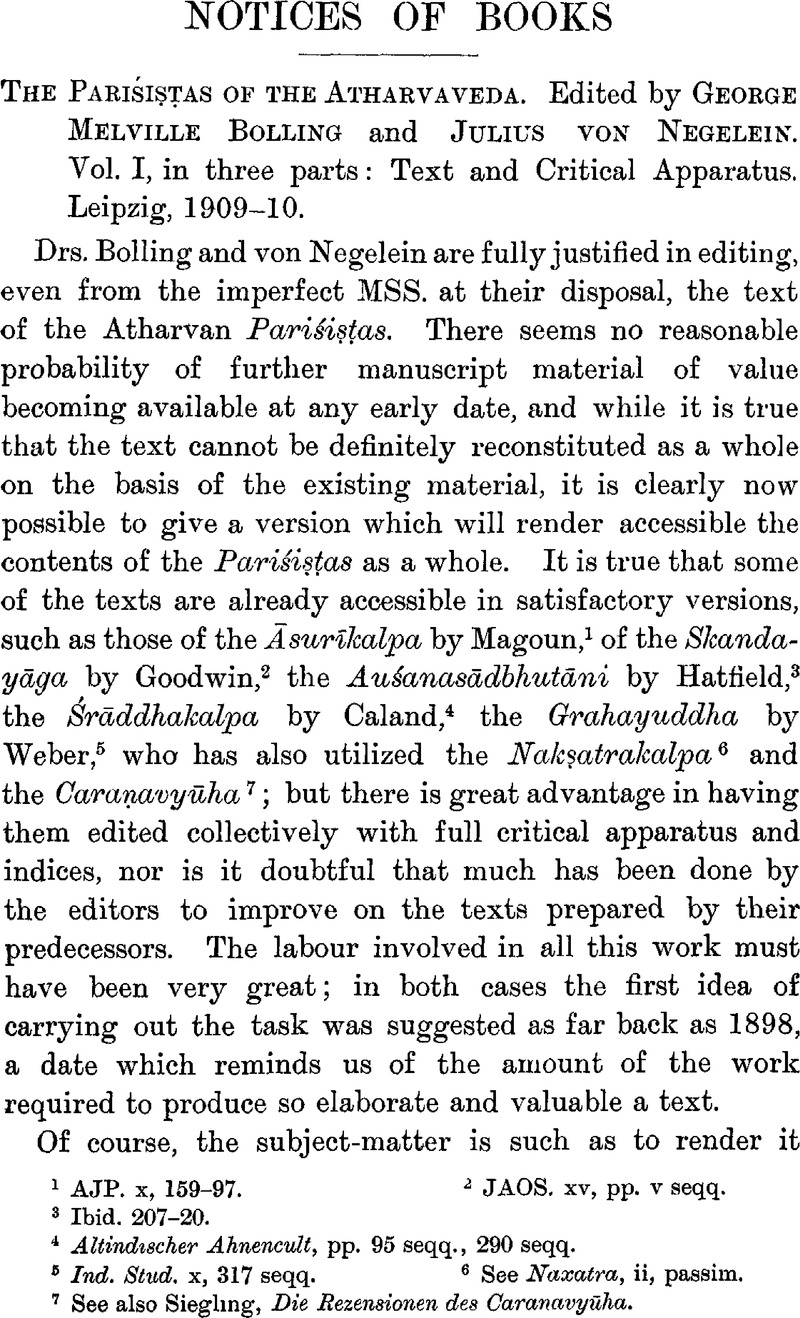No CrossRef data available.
Article contents
The Pariśiṣṭas of the Atharvaveda. Edited by George Melville Bolling and Julius von Negelein. Vol. I, in three parts: Text and Critical Apparatus. Leipzig, 1909–1910.
Published online by Cambridge University Press: 15 March 2011
Abstract

- Type
- Notices of Books
- Information
- Copyright
- Copyright © The Royal Asiatic Society 1912
References
page 755 note 1 AJP. x, 159–97.
page 755 note 2 JAOS. xv, pp. v seqq.
page 755 note 3 Ibid. 207–20.
page 755 note 4 Altindischer Ahnencult, pp. 95 seqq., 290 seqq.
page 755 note 5 Ind. Stud. x, 317 seqq.
page 755 note 6 See Naxatra, ii, passim.
page 755 note 7 See also Siegling, Die Rezensionen des Caranavyūha.
page 756 note 1 Fick's dictum in his review of this work (ZDMG. Ixv, 839), “bei den Pariśiṣṭas griechischer Einfluss ausgesehlossen ist,” is, of course, too light-hearted, and is not really intended; cf. Yavana in 1, 2. 4; li, 1. 3; 3. 3; lvi, 1. 5; lvii, 2. 5; and the Roman dīnīra in xxxvi, 26. 3. He is more nearly correct in connecting the texts on omens with the Purāṇas, and this might help if we could accept the view of MrPargiter, (JRAS. 1912, pp. 254, 255)Google Scholar that the occurrence in inscriptions of certain verses which are found in the Padma, Bhaviṣya, and Brahma Purāṇas affords evidence for the early dating of these Purāṇas. But the only conclusion which the data presented by Mr. Pargiter admit of is that there were current in India various verses regarding the gift of land, and that these are found in inscriptions and Purāṇas. That the Purāṇas did not borrow from any particular inscription is doubtless true, but why should we assume that the inscriptions borrowed from these Purāṇas? A common ancestry for both is obviously to be found in earlier Śāstras, not now extant, and no conclusion can be deduced for the date of the Purāṇas from these verses. To obviate misunderstanding I may say that I quite agree with Mr. Pargiter in not thinking the Purāṇas very modern; cf. my Bodleian Catalogue, Appendix to vol. i, p. 7.
page 762 note 1 Keith, , JRAS. 1907, p. 681Google Scholar. I take this opportunity of correcting Winternitz & Keith, Bodleian Catalogue, No. 1439, where Vajrajāpa should be read for Vajrajaya.
page 768 note 1 The counting makes no claim to absolute accuracy; moreover, in some cases the text is certainly doubtful.
page 769 note 1 It is noteworthy that in xxxvi, 26. 3, the term māṇḍaliko rājā is found, a clear sign of lateness; māṇḍalika occurs also in lxxic, 31. 4.
page 769 note 2 The theory that careless writing explains irregular metre is seldom applicable: in the Kathāsaritsāgara, which is certainly written in decadent Sanskrit, the metre is stiffly regular as a rule; e.g. in sixty-five verses from Taraṅga viii only three irregularities (two third and a first Vipulās) are found.
page 769 note 3 Meyer's edition, p. xi.
page 769 note 4 i, p. xxviii.
page 770 note 1 i, p. 147.
page 770 note 2 pp. v, vi.
page 770 note 3 See Keith, , JRAS. 1906, pp. 1–10Google Scholar; and cf. Oldenberg's, important article in Gött. Nach. 1909, pp. 219–46Google Scholar. I assume throughout that a mute plus a liquid makes position: this is clearly the case.
page 770 note 4 ii, 25. 5 may be disregarded as consisting of two Vedic quotations.
page 772 note 1 Probably only seven; 32. 1 is a doubtful reading: the MSS. favour pṛadakṣiṇam.
page 772 note 2 ii, 1. 1; xiii, 5. 6; xixb, 2. 5; xx, 7. 1; xxxi, 1. 1, 3; xxxiii, 1. 1, etc.
page 773 note 1 See Meyer, , Ṛgvidhāna, pp. ix, xGoogle Scholar.
page 774 note 1 Speyer, , Vedische und Sanskrit-Syntax, p. 61Google Scholar.
page 775 note 1 Keith, , Śāṅkhāyana, Āraṇyaka, p. 46, n. 4Google Scholar.
page 775 note 2 Patañjali on Pāṇini, ii, 2. 18, Vārtt. 5; Wackernagel, , Altind. Gramm. ii, 1, 237Google Scholar.
page 775 note 3 iv, 10.
page 775 note 4 iii, 4.
page 775 note 5 ii, 9.
page 776 note 1 Oldenberg, , SBE. xxix, 121Google Scholar. Paiṭhīnasi occurs only in the Atharvan text; cf. Bloomfield, , Atharvaveda, pp. 17, 18Google Scholar.
page 776 note 2 i, 8; Baudhāyana, i, 1. 2. 9.
page 776 note 3 SBE. xiv, 147.
page 776 note 4 JAOS. xv, pp. xlviii–1.




